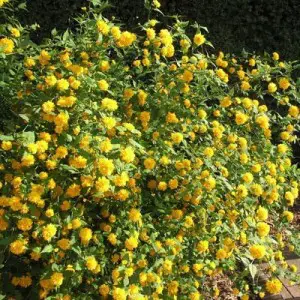Kerria Japanese description
Kerria japonica is a small deciduous shrub that blooms with golden yellow flowers. In the people it is often called the “Easter rose”. And all because of spring flowering and double flowers, which are very similar to miniature roses. In its homeland, in China, kerria reaches a height of up to three meters. In our regions, the shrub grows no more than a meter high.

The bush has a weeping crown shape and bright green shoots that are highly decorative throughout the season. And during flowering, it has no equal: from the end of May – at the beginning of June, the entire bush is covered with many yellow roses that exude a delicate aroma. Flowering lasts for a month, and largely depends on weather conditions. Sometimes kerria blooms again in late summer – early autumn. Its leaves are bright green, serrated, slightly oblong with deep veins. The shrub grows rapidly, and in a few years a wide dense bush is formed.
How to grow kerria japonica?
Kerria is quite resistant to drought, but we recommend planting it in moist and fertile areas. Grows well in both sun and partial shade. But still, we advise you to plant it in partial shade, so that the soil in the root zone does not dry out. In addition, the flowers fade in the sun and fade faster. In the shade, kerria also blooms, but not so abundantly. It is very important that in the place where the kerria will grow, there are no drafts and strong winds. Very often, in winter, tender branches are damaged by winds and sunburn. Therefore, the best option is to give her a place under a sparse canopy of trees, or somewhere in a quiet corner.
If you have it growing in an unprotected place, then it needs shelter for the winter. At the end of November, if possible, bend the branches (after tying them into a bundle) to the ground and cover with spruce branches and agrofibre. Try to keep the winter dry. Kerria is a fairly winter-hardy plant, even if the branches freeze, the plant quickly recovers, new shoots grow.
When and how to land a Japanese kerria?
Kerria seedlings should be planted in early spring or autumn, when the plant is at rest (without leaves). Seedlings with a closed root system can be planted throughout the year. In the spring, planting is carried out after the soil thaws (late March – April), in the fall – a month before the soil freezes (October – early November), so that the plant has time to take root.
Dig a planting hole 60×60 cm in size and about 50 cm deep. Add humus or compost and a handful of complex mineral fertilizer into it. Plant a seedling, fill the hole with nutrient soil and water well. After planting, mulch the root zone, a 5 cm layer of mulch. This will prevent moisture from evaporating and the plant will take root faster. Water your plants regularly, especially during hot and dry weather.
Does Japanese kerria need pruning?
To keep the bush compact and flowering abundant, kerria bushes need to be pruned annually. In the spring, carry out cosmetic pruning, that is, remove frozen, damaged and dry branches. Trim frozen branches to healthy tissue. After flowering, shorten the branches in the summer to maintain the shape of the bush. After such pruning, the bush begins to bush more strongly and becomes incredibly beautiful. Annually, in spring or autumn, carry out anti-aging pruning, completely (at the root) cut out several of the oldest branches. This stimulates the growth of new, young shoots.
In summer, after pruning, it is advisable to feed the bush with organic (compost and ash is an ideal fertilizer) or complex mineral fertilizer.
How does the Japanese kerria reproduce?
Kerria japonica is propagated by cuttings, division of bushes, layering and root shoots. The easiest and fastest way to separate the root growth, which forms a lot, and land in a new place in the garden. The second way is to propagate kerria by layering. In the spring, as soon as the soil warms up, but the buds have not yet woken up, tilt the shoot that grows closer to the soil. Place it in the prepared small groove (depth 5 – 7 cm) and fix it with wire pins. After three to four weeks, when the buds bloom, fill the groove with fertile soil, inserting only the top of the shoot on the surface. Keep the soil slightly moist at all times. In autumn, roots form on the shoot, but it will be possible to separate it from the mother bush only in spring. We recommend covering rooted layers for the winter.
Cuttings also give excellent results. Cuttings can be carried out in spring and summer, after flowering (in June). Cut the cuttings so that each has two internodes. Plant the prepared cuttings in a greenhouse with light soil and sand. Cover greenhouses with glass or film, water and ventilate regularly. For the winter, cover the cuttings in the greenhouse with dry foliage. In the spring of next year, plant the cuttings on seedling beds for growing. Young seedlings can be planted in the garden in a permanent place in a year.
Published: 31.07.2014
